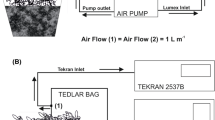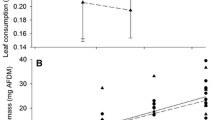Abstract
The release of mercury (Hg) from leaf tissue was compared between two dominant salt marsh macrophytes,Spartina alterniflora andPhragmites australis. Rates of Hg release were measured for individual leaves from late May to late July, along with concentrations of Hg in leaf tissue, rates of sodium (Na) release, and rates of transpiration. Leaves ofS. alterniflora consistently releasd 2–3 times more Hg than leaves ofP. australis. Leaves ofS. alterniflora also contained greater concentrations of Hg during these months. In contrast toP. australis leaves, rates of Na release were high forS. alterniflora and were correlated with rate of Hg release. Transpiration rates averaged 2.2 times greater forPhragmites as compared toS. alterniflora, and were not correlated with the other variables at the leaf level for either species. Leaf Hg concentration was highly correlated with Hg release for both species, but the slope was significantly greater forS. alterniflora. Monthly differences were profound for all climate and physiological variables measured, with high measurements in May, and lower measurements in June and July. For both species, the highest Hg content was found in lower leaves in May, followed by upper leaves in May. Hg accumulation in leaf tissue and release from both species appear to be greatest in the spring, although differences between the species persist throughout these peak months of the growing season.
Similar content being viewed by others
Literature Cited
Abacus Concepts. 1998. SuperAnova. Abacus Concepts, Inc. Berkeley, California.
Berk, S. G. andR. R. Colwell. 1981. Transfer of mercury through a marine microbial food web.Journal of Experimental Marine Biology and Ecology 52:157–172.
Burke, D. J., J. S. Weis, andP. Weis. 2000. Release of metals by the leaves of the salt marsh grassesSpartina alterniflora andPhragmites australis.Estuarine and Coastal Shelf Science 51:153–159.
Chambers, R. M., L. A. Meyerson, andK. Saltonstall. 1999. Expansion ofPhragmites australis into tidal wetlands of North America.Aquatic Bolany 64:261–273.
Craft, C. B., E. D. Seneca, andS. W. Broome. 1994. Loss on ignition and Kjeldahl digestion for estimating organic carbon and total nitrogen in estuarine marsh soils: Calibration with dry combustion.Estuaries 14:175–179.
Fell, P. E., S. P. Weissbach, D. A. Jones, M. A. Fallon, J. A. Zeppieri, E. K. Faison, K. A. Lennon, K. L. Newberry, andL. K. Reddington. 1998. Does invasion of oligohaline tidal marshes by reed grassPhragmites australis affect the availa bility of prey resources for the mummichog,Fundulus heteroclitus? Journal of Experimental Marine Biology and Ecology 222:59–77.
Gallagher, J. L. andH. V. Kibby. 1980. Marsh plants as vectors in trace metal transport in Oregon tidal marshes.American Journal of Botany 67:1069–1074.
Giblin, A. E., A. Bourg, I. Valiela, andJ. M. Teal. 1980. Uptake and losses of heavy metals in sewage sludge by a New England salt marsh.American Journal of Botany 67:1059–1068.
Giblin, A. E., G. W. Luther III, andI. Valiela. 1986. Trace metal solubility in salt marsh sediments contaminated with sewage sludge.Estuarine Coastal and Shelf Science 23:477–498.
Harshberger, J. W. andV. G. Burns. 1919. The vegetation of the Hackensack marsh—A typical American fen. Transactions of the Wagner Free Institute of Science of Philadelphia. Wagner Free Institute of Science, Philadelphia, Pennsylvania.
Hatch, W. R. andW. L. Ott. 1968. Determination of submicrogram quantities of mercury by atomic absorption spectrophotometry.Analytical Chemistry 40:2085–2087.
Heller, A. A. andJ. H. Weber. 1998. Seasonal study of speciation of mercury (II) and monomethylmercury inSpartina alterniflora from Great Bay Estuary, NH.The Science of the Total Environment 221:181–188.
Kraus, M. L. 1988. Accumulation and excretion of five heavy metals by the salt marsh cordgrassSpartina alterniflora.Bulletin of the New Jersey Academy of Sciences 33:39–43.
Kraus, M. L., P. Weis, andJ. H. Crow. 1986. The excretion of heavy metals by the salt marsh cordgrass,Spartina alterniflora, andSpartina’s role in mercury cycling.Marine Environmental Research 20:307–316.
Lee, R. W., D. W. Kraus, andJ. E. Doeller. 1999. Oxidation of sulfide bySpartina alterniflora roots.Limnology and Oceanography 44:1155–1159.
Lissner, J. andH. Schierup. 1997. Effects of salinity on the growth ofPhragmites australis.Aquatic Botany 55:247–260.
Luther III,G. W. andT. M. Church. 1988. Seasonal cycling of sulfur and iron in porewaters of a Delaware salt marsh.Marine Chemistry 23:295–309.
Matsushita, N. andT. Matoh. 1991. Characterization of Na+ exclusion mechanisms of salt-tolerant reed plants in comparison with salt-sensitive rice plants.Physiologica Planta 83:170–176.
McGovern, T. A., L. J. Laber, andB. C. Gram. 1976. characteristics of the salts secreted bySpartina allerniflora Loisel and their relation to estuarine production.Estuarine and Coastal Marine Science 9:351–356.
Odum, W. E. 1988. Comparative ecology of tidal freshwater and salt marshes.Annual Review of Ecology and Systematics 19:147–176.
Orson, R. A. 2000. A paleoecological assessment ofPhragmites australis in New England tidal marshes: Changes in plant community structure during the last few millennia.Biological Invasions 1:149–158.
Orson, R. A., R. S. Warren, andW. A. Niering. 1987. Development of a tidal marsh in a New England river valley.Estuaries 10:20–27.
Otte, M. L. 1991. Heavy Metals and Arsenic in Vegetation of Salt Marshes and Floodplains. Centrale Huisdrukkerij Vrije Universiteit, Amsterdam.
Pomeroy, L. R. 1970. The strategy of mineral cycling.Annual Review of Ecology and Systematics 1:170–190.
Rooth, J. andC. Stevenson. 2000. Sediment deposition patterns inPhragmites australis communities: Implications for coastal areas threatened by rising sea-level.Wetlands Ecology and Management 8:173–183.
Shaw, A. J. 1991. Heavy Metal Tolerance in Plants: Evolutionary Aspects. CRC Press, Boca Raton, Florida.
Shierup, H. andV. J. Larsen. 1981. Macrophyte cycling of zinc, copper, lead and cadmium in the littoral zone of a polluted and a non-polluted lake. II. Seasonal changes in heavy metal content of aboveground biomass and decomposing leaves ofPhragmites australis (Cav.) Trin.Aquatic Botany 11:211–230.
Sundby, B., C. Vale, I. Cacdor, F. Catarino, M. Madureira, andM. Caetano. 1998. Metal rich concretions on the roots of salt marsh plants: Mechanism and rate of formation.Limnology and Oceanography 43:245–252.
Verkleij, J. A. C. andH. Schat. 1990. Mechanisms of metal tolerance in higher plants, p. 179–194.In A. J. Shaw (ed.), Heavy Metal Tolerance in Plants: Evolutionary Aspects. CRC Press, Boca Raton, Florida.
Wainright, S. W., M. P. Weinstein, K. W. Able, andC. A. Currin. 2000. Relative importance of benthic microalgae, phytoplankton and the detritus of smooth cordgrassSpartina alterniflora and the common reedPhragmites australis to brackishmarsh food webs.Marine Ecology Progress Series 200:77–91.
Waisel, Y. 1977. Salt excretion inAvicennia marina, p. 1–21.In A. J. Davy (ed.), Proceedings of the 1st European Ecology Symposium, Ecological Processes in Coastal Environments. University of East Anglia, Norwich.
Waisel, Y., A. Eshel, andM. Agami 1986. Salt balance of leaves of the mangroveAvicennia marina.Physiologica Planta 67:67–72.
Weis, J., L. Windham, and P. Weis. In press. Growth, survival, and metal accumulation by marsh invertebrates fed diets of detritus fromSpartina alterniflora Loisel andPhragmites australis Cav. Trin. ex Steud. from metal contaminated and clean sites.Wetland Ecology and Management.
White, D. S. andB. L. Howes. 1994. Long-term15N-nitrogen retention in the vegetated sediments of a New England salt marsh.Limnology and Oceanography 39:1878–1892.
Windham, L. 1999. Effects of an invasive reedgrass,Phragmites australis, on nitrogen cycling in brackish tidal marshes of New York and New Jersey. Ph. D. Dissertation, Rutgers University, New Brunswick, New Jersey.
Windham, L. andR. G. Lathrop. 1999. Effects ofPhragmites australis (Common Reed) on aboveground biomass and soil properties in brackish tidal marsh of the Mullica River, New Jersey.Estuaries 22:927–935.
Windham, L., J. Weis, andP. Weis. 2001. Lead uptake, distribution, and effects in two dominant salt marsh macrophytes,Spartina alterniflora (cordgrass) andPhragmites australis (common reed).Marine Pollution Bulletin 10:811–816.
Windham, L., J. Weis, and P. Weis. In press. Uptake and distribution of metals in two dominant salt marsh macrophytes,Spartina alterniflora (cordgrass) andPhragmites australis (common reed).Estuarine, Coastal and Shelf Science.
Windom, H. L., W. Gardner, J. Stephens, andF. Taylor. 1976. The role of methlylmercury production in the transfer of mercury in salt marsh ecosystems.Estuarine and Coastal Marine Science 4:579–583.
Wright, D. J. andM. L. Otte. 1999. Wetland plant effects on the biogeochemistry of metals beyond the rhizosphere.Proceedings of the Royal Irish Academy 99:3–10.
Source of Unpublished Materials
Farnsworth, E. Unpublished Data. New England Wild Flower Society, 180 Hemenway Road, Framingham, Massachusetts 01701.
Author information
Authors and Affiliations
Corresponding author
Rights and permissions
About this article
Cite this article
Windham, L., Weis, J.S. & Weis, P. Patterns and processes of mercury release from leaves of two dominant salt marsh macrophytes,Phragmites australis andSpartina alterniflora . Estuaries 24, 787–795 (2001). https://doi.org/10.2307/1353170
Received:
Accepted:
Issue Date:
DOI: https://doi.org/10.2307/1353170




